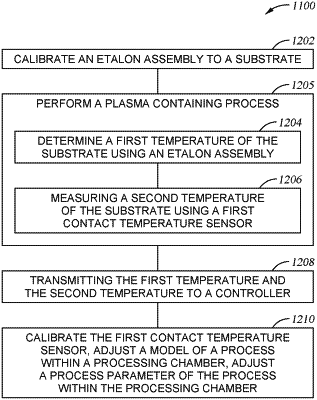| CPC G01J 5/58 (2013.01) [H01J 37/32522 (2013.01); H01L 22/12 (2013.01); G01J 2005/583 (2013.01); H01J 2237/24585 (2013.01); H01J 2237/334 (2013.01)] | 19 Claims |

|
1. A method of sensing temperature suitable for use in a semiconductor processing chamber, the method comprising:
passing a first light beam through a first etalon;
passing the first light beam through a substrate disposed in the processing chamber, the substrate providing a second etalon;
generating a reflected second beam and a transmitted second beam from the first light beam after passing the reflected second beam through both of the first etalon and the second etalon;
determining fringe spacing from an interference pattern of one of the reflected second beam or the transmitted second beam;
determining a temperature of the substrate based on the fringe spacing; and
calibrating a substrate temperature sensor of the processing chamber using the temperature determined based on the fringe spacing of the interference pattern.
|
|
11. A method of sensing temperature suitable for use in a semiconductor processing chamber, the method comprising:
passing a first light beam through a first etalon;
passing the first light beam through a substrate disposed in the processing chamber, the substrate providing a second etalon;
generating a reflected second beam and a transmitted second beam from the first light beam after passing the reflected second beam through both of the first etalon and the second etalon;
determining fringe spacing from an interference pattern of one of the reflected second beam or the transmitted second beam; and
determining a temperature of the substrate based on the fringe spacing,
wherein before the determining the fringe spacing, the processing chamber and the substrate are brought to a steady state temperature and a thickness of the substrate is calculated using an initial substrate temperature measurement and a first thickness of the first etalon is adjusted to be within 10 μm of a second thickness of the substrate by moving the first etalon out of a path of the first light beam and placing an alternate first etalon in the path of the first light beam.
|